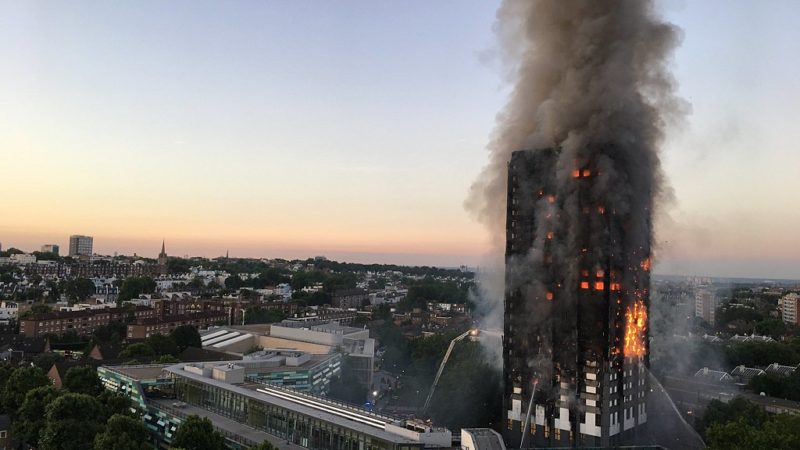The government has continued to cut fire services since Grenfell.

The Fire Brigades Union (FBU) has warned that the government has failed to take measures to prevent a repeat of the Grenfell Tower tragedy.
The union said that cuts mean not enough fire engines will be sent to a high rise fire, especially outside of London.
The FBU’s research reveals that some local authorities are planning to initially send seven water-pumping fire engines to a high-rise fire. Others plan to send just one.
40 fire engines were sent to Grenfell Tower. The FBU said that “resources outside of London are so stretched that fire and rescue services would not be able to mobilise anywhere near that scale”.
The union described this as a “postcode lottery of preparedness demonstrating the detrimental effects of the fragmentation of the fire and rescue service”.
The FBU is calling on the government to implement national standards for the number of firefighters and fire engines which would initially be sent to fires in high-rise blocks,
The fire union also criticised continued cuts to fire and rescue services after Grenfell.
The Conservative-Liberal Democrat coalition government cut fire services and English fire funds from central government have been cut by another 15% from 2016/17 to 2019/20.
The FBU also accused Tory fire minister Nick Hurd of failing to understand one of the key causes of the Grenfell fire – the failure of compartmentation.
Compartmentation is the principle whereby buildings are built divided into fire-resistant compartments.
The failure of compartmentation at Grenfell Tower was one of the reasons the fire spread so fast.
The FBU wants a national review to understand the scale of failed compartmentation in residential buildings.
One of the reasons compartmentation was undermined was the flammability of the tower’s cladding.
The FBU said there are at least 338 residential buildings wrapped in the same type of ACM cladding.
The union added that the government has not begun to assess the risk from other flammable cladding.
“There is still no adequate national picture of buildings where fire compartmentation has been undermined in other ways,” the FBU said.
Another cause of the high death-count was the ‘stay put’ policy – which advised residents to stay in their homes rather than try to escape the building.
The reasoning behind this policy is that compartmentation would work and the fire would not spread.
The FBU has called for a review of this policy but the government has not agreed to this.
According to the FBU, Nick Hurd has repeatedly claimed that local fire services are prepared for a Grenfell-type fire.
However, the Home Office have contacted only three of the 48 fire and rescue services outside of London to ask if they’re prepared.
A further eight have been contacted by the National Fire Chiefs Council and one by the Welsh government.
Commenting, FBU national secretary Matt Wrack said:
“We’re shocked at the utter complacency of the Fire Minister. 72 people died at Grenfell Tower, a fire for which London Fire Brigade had not planned. Yet the minister still does not grasp the severity, or even the basic details, of the risk across the country.”
“It’s no longer possible to claim that fire like Grenfell is unforeseeable. Firefighters were placed in an impossible situation that night. But two years on, the government still has not provided the planning and resources necessary to prepare firefighters for what are now completely foreseeable risks.
“It is extremely worrying that as part of their pre-determined attendances, some services only plan to send two engines to a fire in a high rise building. That is nowhere near enough to tackle a blaze which occurs when compartmentation fails, like it did at Grenfell.
“Fire and rescue services are clearly basing their pre-determined attendances upon a situation where compartmentation works. But at Grenfell it was the failure of compartmentation that caused the fire to spread so rapidly and virtually none are prepared for such an incident.
“Even with this optimistic assumption, the levels of attendance are mostly utterly inadequate. The difference in pre-determined attendances is also deeply worrying – there is no reason why which part of the country a building is located in should determine the safety of its residents.”
“Grenfell proved the UK government’s utter complacency on fire safety. We need robust national standards to make sure that the lessons from that night are applied everywhere.”
Joe Lo is a reporter for Left Foot Forward




2 Responses to “Fire union: ‘Government complacency risks another Grenfell’”
Patrick Newman
Never mind complacency it is betrayal that should concern us all. Betrayal of the Grenfell residents and local community by the Inquiry, its Chair – Sir Martin Moore-Bick – and of course the government! The government are culpable for the mortality of residents as they preferred to have a bonfire of regulations instead of avoiding a bonfire of 72 people. There is no excuse because they were told about the dangers by the coroner of the Lakanal House fire (see:- https://www.lambeth.gov.uk/sites/default/files/ec-letter-to-DCLG-pursuant-to-rule43-28March2013.pdf ) and May’s current Chief of Staff was tasked to do something when he was a Croydon M.P. but did FCUK all about it. The Inquiry is being managed by Moore-Bick to avoid the embarrassment of the government by delaying the first phase which will then delay the second phase which deals with the causes of the faults with the cladding which will not be published until well into the next decade! Some in the industry are fighting a rearguard action to water down any regulations.
Dave Roberts
There is a good account of council complacency at http://www.helalabbas.com in the article From Gloucester Place to Grenfell Tower by someone who has first hand experiences of these tragedies. Click My Thoughts and then the article although everything he writes is of interest.